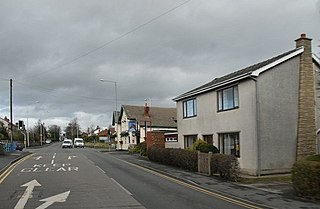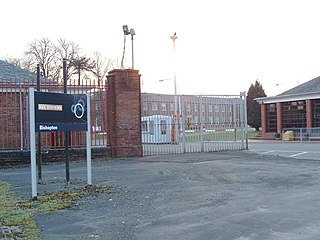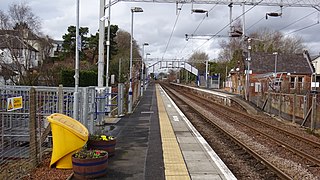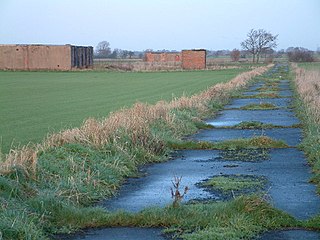
Birchwood is a town in the Borough of Warrington, Cheshire, England with a population of 11,395. Although physically and administratively part of Warrington, the civil parish council has named itself a town council. Historically part of Lancashire, it was built during the time of much expansion in Warrington as it became a "new town". Birchwood is separated into three residential estates: Gorse Covert, Oakwood and Locking Stumps, with all the main facilities grouped around the centre.

Bishopton (/bɪʃəptən/) is a village in Renfrewshire, Scotland. It is located around 2 miles (3 km) west of Erskine.
ROF Glascoed was initially a UK government-owned, Royal Ordnance Factory (ROF). It was designed as one of 20 munitions filling factories. It was planned as a permanent ROF with the intention that, unlike some other similar facilities, it would remain open for production after the end of World War II. After privatisation of the Royal Ordnance Factories in the 1980s it became part of Royal Ordnance plc and later a production unit of BAE Systems. It was served by the Great Western Railway's Coleford, Monmouth, Usk and Pontypool Railway from its opening in April 1940 until 1993.

Euxton is a village and civil parish of the Borough of Chorley, in Lancashire, England. The population of the civil parish as taken at the 2011 census was 9,993, however, the population is now significantly higher due to the increase in housing developments in the village, including the Buckshaw development. The village is situated just to the west of Chorley, and to the south of Clayton-le-Woods.
Royal Ordnance Factories (ROFs) was the collective name of the UK government's munitions factories during and after the Second World War. Until privatisation, in 1987, they were the responsibility of the Ministry of Supply, and later the Ministry of Defence.

The Royal Ordnance Factory was a WW2 Ministry of Supply Explosive Factory. It is sited adjacent to the village of Bishopton in Renfrewshire, Scotland. The factory was built to manufacture the propellant cordite for the British Army and the Royal Air Force. It also later produced cordite for the Royal Navy. The Ministry of Works were responsible for the site. It was the biggest munitions factory the MOD had, with up to 20,000 workers.

Euxton Balshaw Lane is one of two railway stations situated in Euxton, Lancashire, England. It is a local station on the West Coast Main Line on the stretch between Wigan and Preston.

Dunham-on-the-Hill is a village and former civil parish, now in the parish of Dunham-on-the-Hill and Hapsford, in the unitary authority of Cheshire West and Chester, and the ceremonial county of Cheshire, England. It is on the A56 road, approximately 2.3 miles (3.7 km) from Helsby and 6 miles (9.7 km) from Chester. The village is 120 feet (37 m) above sea level, south west of Helsby Hill.

East Goscote is a modern village and civil parish in the Borough of Charnwood district of Leicestershire, England, just north of the market town of Syston. It is a medium-sized village, with a population measured at 2,866 in the 2011 census. The village is twinned with Fleury-sur-Andelle, France.

Bishopton railway station serves the village of Bishopton in Renfrewshire, Scotland. The station is on the Inverclyde line, 13 miles (21 km) west of Glasgow Central. It opened on 29 March 1841. The station is managed by ScotRail.

ROF Chorley was a UK government-owned munitions filling Royal Ordnance Factory. It was planned as a permanent Royal Ordnance Factory with the intention that it, unlike some other similar facilities, would remain open for production after the end of World War II; and, together with ROF Bridgend, would replace the Royal Filling Factory located at the Royal Arsenal, Woolwich. It was built largely in Euxton, but was known as ROF Chorley.

Neville Hill is a railway train maintenance depot in Osmondthorpe, Leeds, England on the Leeds to Selby Line. The depot is situated 2 miles 14 chains (3.5 km) to the east of Leeds railway station on the north side of the line.

These are narrow-gauge railways at military establishments and former UK Government-owned explosives sites. These locations were often subject to the Official Secrets Act and other government restrictions, so many of them are less well documented.
The Stratford on Avon and Broadway Railway project (SBR) was an English railway project whose aim was to re-open the closed railway line from Stratford-upon-Avon, Warwickshire to Honeybourne railway station, Worcestershire for main-line re-connection.

Ealing Common Depot is a London Underground railway depot on the District line, located between Acton Town and Ealing Common stations in west London, England. It is the oldest of the main depots on the Underground, having been built in 1905, when the District Railway was upgraded for electric traction. All depot facilities were moved there from Lillie Bridge Depot, and it was known as Mill Hill Park Works. It subsequently became Ealing Common Works, and its status was reduced to that of a depot in 1922, when Acton Works was opened, and took over responsibility for all major overhauls. Most of the functions of Acton Works were devolved back to the depots, including Ealing Common, in 1985.
Ruddington Ordnance & Supply Depot was a Royal Ordnance Factory filling and storage facility, commissioned in 1940 and built during World War II by the United Kingdom Ministry of Defence (MoD). It was located to the south of Ruddington, Nottinghamshire, and took 18 months to build. In operation it consisted of over 200 buildings employing 4,000 workers at peak. It was decommissioned in 1945, became a storage area for ex-military vehicles which were then auctioned-off onsite, and was closed in 1985. Today the site is located in the Rushcliffe Country Park.

The Coleford, Monmouth, Usk & Pontypool Railway (CMU&PR) was a standard gauge railway of 16 miles (26 km) which ran from Monmouth to Little Mill, near Pontypool in Monmouthshire, Wales. It was intended to convey the mineral products of the Forest of Dean to the ironworks of South Wales, by connecting to the Newport, Abergavenny and Hereford Railway at Little Mill Junction. The NAHR made the onward connection over its Taff Vale Extension line. The CMU&PR intended to acquire the Monmouth Railway, actually a horse-operated plateway, and convert it to locomotive operation.

A coaling tower, coal stage, coaling plant or coaling station is a facility used to load coal as fuel into railway steam locomotives. Coaling towers were often sited at motive power depots or locomotive maintenance shops.

Simonswood Supply Depot was one of the main ammunition depots in Lancashire, England during World War II. Located at Simonswood, it was used as an ammunition depot delivered by ROF Kirkby. The remains of the ammunition bunkers still exist today.















